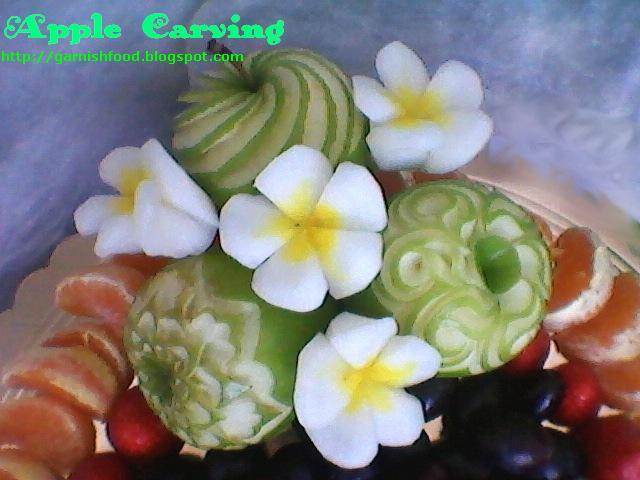I love to carve apples. Apple is a perfect material, pattern carved on its skin has a wonderful contrast. This fruit is always availiable at market, so I often add a carved apple to my arrangements.
The most popular questions I have ever asked is about preventing apples from browning. Indeed, apples easily get dark and can spoil overall impression of your display. In this post I will show and explain what I do to keep carved apple fresh.
Apple carving for fruit displays
These apples were created as fruit plate's decoration. The apples were carved 12 hours before the photos were taken. They were kept in a fridge overnight, and I am sure they will stay in good condition more 5 or 6 hours that they are supposed to be displayed (I have checked that :-))
 |
| Apple carving |
 |
| Apple carving for fruit display |
 |
| Green apples and fragipani flowers |
Did you notice that I also love adding frangipani flowers to my displays? This flower was showed me by
Khun Narata at her carving class in Chiang Mai, Thailand. I found the flower useful for carving bouquets. It looks sunny and bright. This type of flower carving keeps good shape during displaying, without getting weak (this is a very important point).
A florist friend told me off for using yellow color repeatedly in my displays. Well, I like yellow color, it looks appealing to eat :-) Do you think so?
 |
| Apple carving details |
 |
| Apple garnish for fruit plate |
How to carve apples and prevent them from turning brown
There are a few tips on carving apples:
1. Do not carve apples deep inside unless you want them getting dark quickly. Beautiful patterns can be done on the contrast between red/green skin and white flesh, whithout deep cuts.
2. To safe the carved parts white treat them with lemon juice.
I do the following trick. Dissolve lemon acid crystals in water. Dip the apple in the water each time after carving a number of elements and lines. This makes a carved pattern lasting for hours.
3. Wrap a carved apple in food wrap to avoid oxygen make its business.
4. Keep carved apples in a cold place or in a fridge.
 |
| Dissolve lemon acid in water |
 |
| Carve a number of elements |
 |
| Dip the apple in acid water to treat the white parts |
 |
| Carve other section of the pattern and dip the apple in acid water again. |
 |
Continie carving and dipping.
Your pattern may take a time, so applying acid water to new details
will secure your nice apple centerpiece |
 |
| Cover the carved apple witn a food plastic wrap to keep the apple away from air |





















